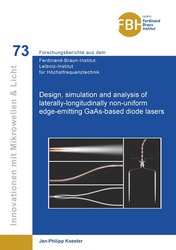| Departments | |
|---|---|
| Book Series (96) |
1377
|
| Nachhaltigkeit |
3
|
| Gesundheitswesen |
1
|
| Humanities |
2361
|
| Natural Sciences |
5403
|
| Mathematics | 229 |
| Informatics | 318 |
| Physics | 979 |
| Chemistry | 1362 |
| Geosciences | 131 |
| Human medicine | 243 |
| Stomatology | 10 |
| Veterinary medicine | 108 |
| Pharmacy | 147 |
| Biology | 835 |
| Biochemistry, molecular biology, gene technology | 121 |
| Biophysics | 25 |
| Domestic and nutritional science | 45 |
| Agricultural science | 1004 |
| Forest science | 201 |
| Horticultural science | 20 |
| Environmental research, ecology and landscape conservation | 148 |
| Engineering |
1788
|
| Common |
97
|
|
Leitlinien Unfallchirurgie
5. Auflage bestellen |
|
Advanced Search
Design, simulation and analysis of laterally-longitudinally non-uniform edge-emitting GaAs-based diode lasers (Volume 73) (English shop)
Jan-Philipp Koester (Author)Preview
Extract, PDF (290 KB)
Table of Contents, PDF (34 KB)
Edge-emitting quantum-well diode lasers based on GaAs combine a high conversion efficiency, a wide range of emission wavelengths covering a span from 630 nm to 1180 nm, and the ability to achieve high output powers. The often used longitudinal-invariant Fabry-Pérot-type resonators are easy to design but often lead to functionality or performance limitations.
In this work, the application of laterally-longitudinally non-uniform resonator configurations is explored as a way to reduce unwanted and performance-limiting effects. The investigations are carried out on existing and entirely newly developed laser designs using dedicated simulation tools. These include a sophisticated time-dependent laser simulator based on a traveling-wave model of the optical fields in the lateral-longitudinal plane and a Maxwell solver based on the eigenmode expansion method for the simulation of passive waveguides. Whenever possible, the simulation results are compared with experimental data. Based on this approach, three fundamentally different laser types are investigated:
• Dual-wavelength lasers emitting two slightly detuned wavelengths around 784 nm out of a single aperture
• Ridge-waveguide lasers with tapered waveguide and contact layouts that emit light of a wavelength of around 970 nm
• Broad-area lasers with slightly tapered contact layouts emitting at 910 nm
The results of this thesis underline the potential of lateral-longitudinal non-uniform laser designs to increase selected aspects of device performance, including beam quality, spectral stability, and output power.
| ISBN-13 (Hard Copy) | 9783736978829 |
| ISBN-13 (eBook) | 9783736968820 |
| Final Book Format | A5 |
| Language | English |
| Page Number | 170 |
| Lamination of Cover | matt |
| Edition | 1. |
| Book Series | Innovationen mit Mikrowellen und Licht. Forschungsberichte aus dem Ferdinand-Braun-Institut, Leibniz-Institut für Höchstfrequenztechnik |
| Volume | 73 |
| Publication Place | Göttingen |
| Place of Dissertation | TU Berlin |
| Publication Date | 2023-09-19 |
| General Categorization | Dissertation |
| Departments |
Informatics
Electrical engineering |
| Keywords | dual-wavelength laser, tapered laser, high-brightness diode laser, ridge-waveguide laser, broad-area laser,device simulation, traveling-wave laser model, modal analysis, lateral mode filter, spatial hole burning, thermal lensing, Dual-Wellenlängen-Laser, konischer Laser, Hochleistungsdiodenlaser, Ridge-Wellenleiter-Laser, Breitbandlaser, Gerätesimulation, Wanderwellenlasermodell, Modalanalyse, Lateral-Mode-Filter, räumliches Lochbrennen, thermische Linsenbildung |
| URL to External Homepage | https://www.fbh-berlin.de/publikationen/dissertationen |








